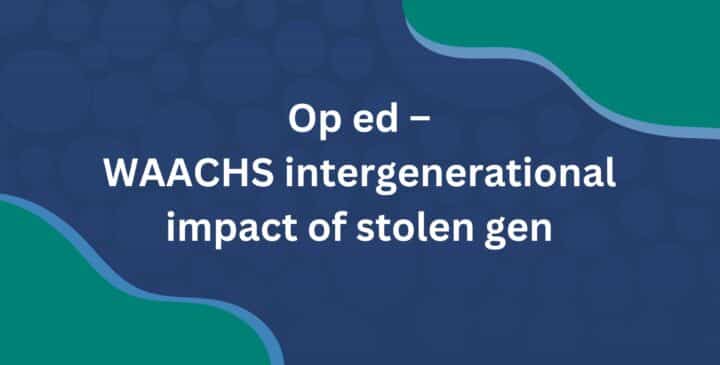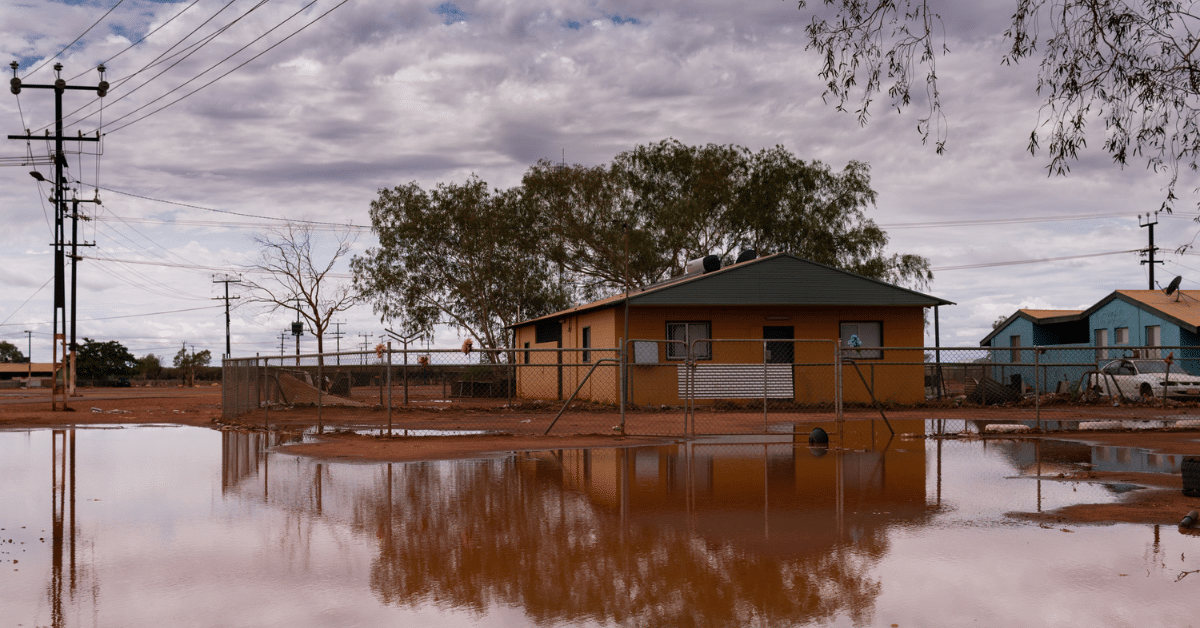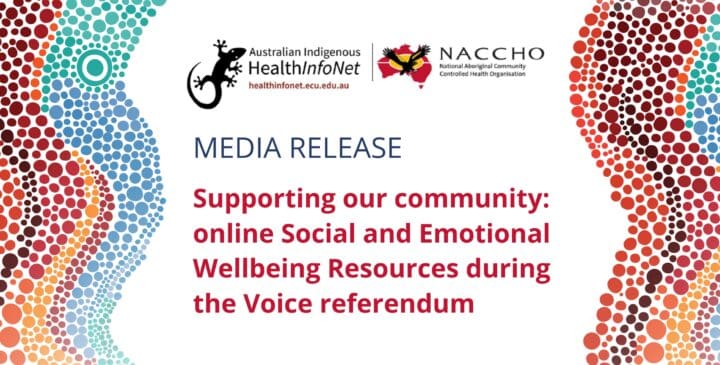

NACCHO Policy Position Paper: Aboriginal Housing for Aboriginal Health
Aboriginal Housing for Aboriginal Health
Housing is a key determinant of health. Aboriginal and Torres Strait Islander people face a range of issues that prevent them from accessing housing that is affordable, adequate, safe and sustainable. Overcrowding is increasingly prevalent, making household members further susceptible to the burden of disease, psychological distress and other health and wellbeing issues.[1] The COVID-19 pandemic is a stark reminder of the importance of housing for maintaining health and slowing and stopping the spread of disease. Significant Australian, State and Territory Government leadership and investment is urgently needed to improve housing and health outcomes for Aboriginal and Torres Strait Islander people.
What is needed
NACCHO is calling for the urgent implementation of the formal policy partnership on housing as envisaged in the National Agreement signed in July 2020. The policy partnership will establish a multi-jurisdictional joined up approach to reduce gaps and duplications in housing policies and programs. The following recommendations must be addressed:
- Implement the four priority reforms in the National Agreement on Closing the Gap to accelerate outcomes in housing including establishing an Aboriginal and Torres Strait Islander Community Controlled Housing Sector.
- Create a new national multilateral funding agreement to address the complexity and diversity of housing needs of all Aboriginal and Torres Strait Islander people across Australia.
- Address the funding shortfall between the goal of the National Housing and Homelessness Agreement to improve access to safe and affordable housing and the investment capable of supporting it.
- Expand the funding and timeframe of the current National Partnership for Remote Housing Northern Territory to match at least that of the former National Partnership Agreement on Remote Indigenous Housing.
- Reverse the collapse of housing stock and improve housing access and affordability, including rent-to-buy social housing initiatives.
- Transfer management of housing tenancy and maintenance and rent-to-purchase programs to Aboriginal and Torres Strait Islander community-controlled housing providers registered under the National Regulatory System for Community Housing Providers.
- Identify the number of new and refurbished houses that are required for Aboriginal and Torres Strait Islander people and establish timeframes and targets for construction and/or maintenance.
- Fund a program that supports healthy living environments in urban, rural, and remote Aboriginal and Torres Strait Islander communities, similar to the Fixing Houses for Better Health program, also delivered by Aboriginal and Torres Strait Islander community housing providers.
- Update and promote the National Indigenous Housing Guide, a best practise resource for the design, construction, and maintenance of housing for Aboriginal and Torres Strait Islander people.
- Implement a rigorous national research, evaluation and data collection program that monitors the impact of Aboriginal and Torres Strait Islander housing policy against health indicators.
- Invest in VET training, apprenticeships, undergraduate degrees, and job opportunities in housing and environmental health for Aboriginal and Torres Strait Islander people in their communities.
- Support achieving housing related outcomes under the new National Agreement on Closing the Gap including a new target of increasing the proportion of Aboriginal and Torres Strait Islander people in appropriately sized (not over-crowded) housing to 88% by 2031.
In the meantime, the availability of and access to emergency and transitional housing must be improved.
Housing for Aboriginal and Torres Strait Islander people
Housing for Aboriginal and Torres Strait Islander people is currently addressed through complex arrangements, across multiple levels of government, made up of social housing programs, public housing, state-owned and managed Aboriginal housing, Indigenous Community Housing Organisations (ICHOs), community housing providers and private ownership.
The Aboriginal and Torres Strait Islander population in Australia is growing and undergoing changes in demographics that influence their housing needs. The Aboriginal and Torres Strait Islander population in Australia is expected to grow to around 1,060,000 by 2031. This is a 63% increase from the 650,000 Aboriginal and Torres Strait Islander people recorded in the 2016 Australian census and includes a medium range projected increase of 66.5% to the population aged 50 and over.[2] Housing policy frameworks and investment needs to account for the expected growth in population and burgeoning needs of older Aboriginal and Torres Strait Islander people to have an effect on closing the gap.
Housing rental issues are particularly pertinent to Aboriginal and Torres Strait Islander people. Most Aboriginal and Torres Strait Islander households (57%—or around 151,000 households) rent their residence as compared to owning it (38.1%), whereas around two-thirds of non-Aboriginal Australians (5.4 million households) are homeowners while 32% (2.6 million) rent their residence.[3] Rent models for remote housing implemented in various jurisdictions are inconsistent with social housing policy objectives of affordability and fairness.[4] Issues impacting housing affordability include: remoteness, the cost of basic necessities, a lack of available goods and services, food security issues, financial management and home economics issues, and an over-reliance on income support payments.
The roles of Federal, State and Territory Governments
All levels of government play significant roles in housing policy and programs.[5] While in 1967 the Australian Government acquired constitutional powers to legislate in respect to Aboriginal and Torres Strait Islander people, the responsibility for the majority of polices applicable to Aboriginal people, including housing, was not removed from State and Territory Governments, but became a shared responsibility.[6] Since 1968, the Federal Government has played an important role in Aboriginal housing (and particularly in remote housing) policy and funding. Some current national initiatives include:
- The National Housing and Homelessness Agreement provides $1.5 billion a year for three years from 1 July 2018 to states/territories for housing need, including Aboriginal housing in cities, inner and outer regional areas, as well as some remote regions with high overcrowding rates.
- The Federal Government has separate funding agreements over five years for remote Aboriginal housing with Queensland ($105 million), Western Australia ($121m), South Australia ($37.5m) and the Northern Territory ($550m).
The intention of the National Partnership on Remote Housing was to meet around half of the remote housing need.[7] However, the Federal Government refused to renew the Agreement without negotiation, discussion or agreement with State and Territory governments and Aboriginal and Torres Strait Islander people. This lack of clear responsibility and accountability for housing policy and investment has left Aboriginal and Torres Strait Islander communities in limbo while affordable housing supply decreases and housing standards deteriorate. Due to the ongoing lack of progress in improving Aboriginal housing and the critical impacts on the health of Aboriginal and Torres Strait Islander people, the formation of an Aboriginal and Torres Strait Islander Housing Sector which is community controlled is essential.
The new Closing the Gap Agreement, between Australian Governments, the Australian Local Government Association the Coalition of Peaks (CoP),[8] provides an opportunity and mechanism for representatives of Governments and Aboriginal and Torres Strait Islander communities to establish agreed housing outcomes for Aboriginal and Torres Strait Islander people.
The impacts of inadequate housing on Aboriginal health
Several causes contribute to substandard housing for Aboriginal and Torres Strait Islander people, including the lack of investment from Australian, State and Territory Governments and a lack of coordinated planning, expenditure and monitoring between them. Other issues include inadequate inspections and supervision of contractors during construction, and little to no enforcement of the Building Code of Australia (BCA) around structural adequacy, fire resistance, access and egress, energy efficiency and sustainability and occupant health and safety.[9] Best practice measures outlined in the National Indigenous Housing Guide are often not adopted and there is a lack of effective tenancy and property management regimes. Constructing homes with poor-quality materials results in deterioration,7 which in turn perpetuates overcrowding as people may need to stay with family and/or friends.
The major issue of overcrowding for Aboriginal and Torres Strait Islander people is largely a result of needing to share housing due lack of supply, low incomes and high rent. Some people may have been evicted from elsewhere, recently moved from another region, are facing family problems, are needing to access local services or are fulfilling funeral or other family, cultural and/or country obligations.[10]
The impacts of inadequate housing on Aboriginal and Torres Strait Islander health and wellbeing are significant and can include a greater incident of accidents from poorly functioning health hardware,[11] greater incidence of diseases such as gastroenteritis, parasitic infections and skin conditions,[12] [13] [14] psychosocial stress and other social and emotional issues.9
Overcrowding can compound psychosocial stress and ill health due to food insecurity, the sharing of limited resources, exposure to tensions and conflict, the lack of privacy and personal space and the prevalence of infectious and chronic diseases due to unhealthy living practices and infrastructure that can’t manage the demand. Parental engagement such as reading and doing homework with children is impeded, as are household rules and routines. The sleep of children and youth can be impacted, which can impede school attendance and performance, and their overall development, health and wellbeing.
The interplay between housing and environmental health
Housing is a crucial social as well as environmental determinant of health.[15] Poverty enhances and entrenches the impact of environmental determinants and makes Aboriginal and Torres Strait Islander people susceptible to preventable illness and premature death.17
In recent years there have been several national level environmental health initiatives that recognise the critical importance of environmental health issues, including the:
- Preventing Disease and Injury through Healthy Environments: Environmental Health Standing Committee (enHealth) Strategic Plan 2016-2020.
- Department of Health’s Expert Reference Panel on Aboriginal and Torres Strait Islander Environmental Health Action Plan 2019-23.
- Implementation Plan for the National Aboriginal and Torres Strait Islander Health Plan 2013-23.
However, without housing policy leadership and investment from Governments that recognises the crucial links between housing and health, the impact of these plans on the health of Aboriginal and Torres Strait Islander people is limited. Community-led and integrated approaches between ACCHOs, housing and environmental health organisations are crucial to arrest poor health outcomes for families and individuals.
Environmental health risk factors
Key environmental health risk factors impacting on Aboriginal and Torres Strait Islander health and wellbeing include: water treatment and supply, food safety (including access to affordable and healthy food), adequate housing and maintenance (including to reduce overcrowding), rubbish collection and disposal, sewage disposal, animal control (including insects), dust control, pollution control and personal hygiene enabled by functioning health hardware (taps, showers, washing machines). To address these risks, healthy environments need to be established and maintained, including via the provision of adequate infrastructure that is built to withstand climate change (housing, water supply, guttering, sewage systems, etc.). Extensive community infrastructure improvements are also required, including: sealed roads, footpaths, curbing and guttering, storm water drainage, recreational areas, power, water and fuel supplies, sanitation and rubbish tips.
Many Aboriginal and Torres Strait Islander families are on low incomes and cannot afford adequate refrigerators for safe food storage and washing machines for cleaning clothing and linen. Subsidies on white goods would improve the health and wellbeing of households by preventing skin diseases, infections and improving food security and of perishable food and medications. ACCHOs have a crucial role to play in promoting healthy living practices in their local communities, which includes washing people, clothes and bedding, removing wastewater safely, improving nutrition, reducing overcrowding, reducing the negative effects of vermin and insects, reducing dust, controlling the temperature and reducing hazards.13 Environmental health programs must be Aboriginal and Torres Strait Islander community controlled to ensure integrated approaches that meet local need.
As well as being designed and built with strong fixtures and fittings (e.g., sustainable windows and doors) to withstand the environmental impacts of climate change, Aboriginal housing should be eco-efficient in design and construction, including temperature control, water, energy and waste management systems.
The issue of ongoing maintenance being undertaken by a qualified regional workforce is critical to systematically managing housing for health. Environmental health staff should be locally recruited and participate in accredited training to qualify to undertake essential work in full partnership with housing, construction, and maintenance community-controlled organisations, preferably on a regional basis. Environmental health programs and ongoing maintenance of housing stock must be Aboriginal and Torres Strait Islander community controlled. Community control of these programs will retain jobs and opportunities within communities, grow the skills and capacity of local people and strengthen and enable links between health and housing, rather than housing, health and environmental health continuing to operate in isolation from each other.
Conclusion
Closing the housing gap between Aboriginal and Torres Strait Islander people and other Australians will go a long way in closing the gap in health and wellbeing. To do this, greater funding for housing for Aboriginal and Torres Strait Islander people in urban, rural and remote areas is essential. It is urgent that a formal policy partnership between Australian, State and Territory Governments and Aboriginal and Torres Strait Islander representatives is established that allows for shared decision-making on initiatives that better enable Aboriginal and Torres Strait Islander people to access affordable, adequate, safe and sustainable housing, and enjoy longer and healthier lives.
NACCHO Policy Position Paper: Aboriginal Housing for Aboriginal Health | DOWNLOAD
[1] Shanaka, H., Bentley, R. (2017). Crowding, housing and health: An exploratory study of Australian cities. Accessed 24/1/2020. [2] Centre for Aboriginal Economic Policy Research (CAEPR), (2011). CAEPR Indigenous Population Project 2011 Census Papers, Paper no.14 Population Projections. Australian National University. [3] Australian Institute of Health and Welfare. (2019). A Focus Report on Housing and Homelessness. Cat. no. HOU 301. Canberra. [4] Australian Housing Urban Research Institute (AHURI). (2019). What is a funding gap and ways to fund it. Accessed 12/2/2020. [5] Australian Government Department of Social Services (2019). Housing Support. Accessed 12/2/2020. [6] AHURI. (2004). Indigenous Housing & Governance: Case Studies from Remote WA & NT, Final Report. No. 66. Accessed 12/2/2020. [7] Dillon, M. (2018). Tactics vs Strategy in Aboriginal Housing, Inside Story, National Affairs. Accessed 23/1/2020 [8] COAG, CoP. (2019). Partnership Agreement on Closing The Gap 2019-2029. Accessed 8/5/2020 [9] Government of South Australia, 2020, Building Code of Australia. Accessed 24/1/2020 [10] AHURI. (2012). Australian Indigenous House Crowding. Final Report No. 194. Accessed 12/2/2020. [11] AIHW & AIFS. (2013). Housing Strategies that Improve Indigenous Health Outcomes. Resource sheet no. 25. [12] Bailie, R., et al. McDonald, E., Stevens, M,, Guthridge, S., Brewster, D. (2011). Evaluation of an Australian Indigenous housing programme: community level impact on crowding, infrastructure function and hygiene. J Epidemiol Comm Health. 65(5): 432-7. [13] Booth, A., Carroll, N. (2005). Overcrowding and Indigenous Health in Australia. CEPR, ANU. Accessed 10/1/2020. [14] Farrar, A., Barbato, C., & Phibbs, P. (2012). How community housing strengthens communities. (37). Accessed 25/1/2020. [15] Prüss-Üstün, A., & Corvalán C., (2006). Preventing Disease through Healthy Environments: Towards an Estimate of the Environmental Burden of Disease. World Health Organisation.

